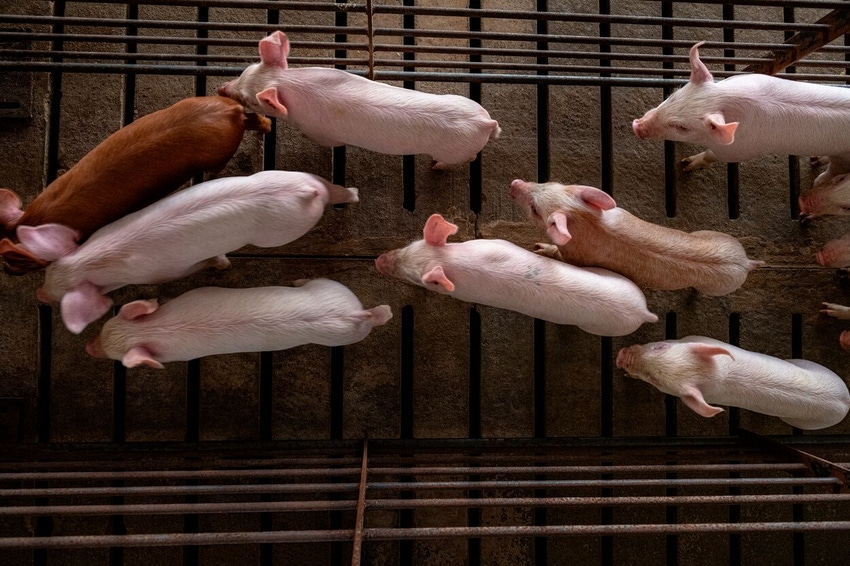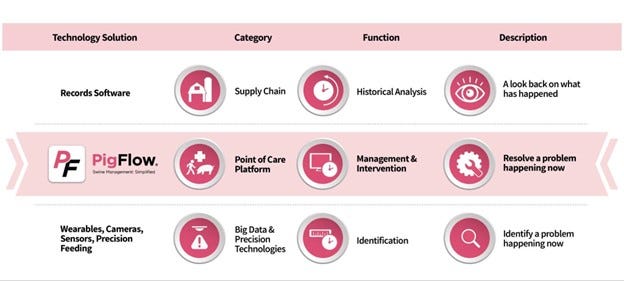What is the modern swine technology landscape?
The swine industry has begun to implement a three-tiered system that promises to enhance every aspect of swine production.
December 27, 2023

By Matthew Rooda, SwineTech
The arrival of sophisticated technology in the swine industry marks a pivotal transition towards a more data-driven and precise approach to livestock management, similar to the revolutionary changes seen in the healthcare sector. As we delve into the three-layered swine technology landscape, we uncover a model that closely resembles the compartmentalization of healthcare technologies into data handling, patient care and precision diagnostics—each layer distinct yet interconnected, creating a robust framework for operational excellence.
Introduction: A new era of swine technology
In the realm of modern agriculture, particularly within the swine industry, a paradigm shift is unfolding as producers move toward higher-tech and more sustainable operations. This shift is characterized by the adoption of a layered technological approach, directly inspired by the stratification of healthcare technologies.
In healthcare, the division of technology into layers for handling patient records, providing care and conducting precise diagnostics has resulted in unprecedented efficiency and patient outcomes. Similarly, the swine industry has begun to implement a three-tiered system that promises to enhance every aspect of swine production—from the health and growth of the animals to the optimization of feed consumption and overall farm management.
First layer: Records and data systems
In the first layer, records and data systems form the backbone of the technology stack, similar to EMR/EHR systems in healthcare. These platforms record historical data on swine health, growth rates, feed consumption and other critical metrics. They serve as a repository for vast amounts of data collected over time, allowing for historical analysis and strategic planning. By evaluating the benefits of past activity, especially via monitoring systems that account for a farmer as their end users, decision-makers can analyze performance trends, identify areas for improvement, and make data-driven decisions to enhance future operations.
Second layer: Human-centered point-of-care solutions
The second layer, represented by point-of-care solutions like SwineTech's PigFlow, acts as the operational core. The objective of this step is sending the right information to the right person at the right time. This step is not properly performed in many cases and is an overlooked reason for data underuse. Sometimes information arrives late and is useless (i.e., hypo-productive sows to be culled if report arrives after mating), or it is too complex for farm staff or too basic for veterinarians or managers. User preferences must also be considered and can include various types (electronic files, text messages, or web applications).
This layer focuses on the present, enabling immediate action and compliance. When the first layer provides insights into historical trends, the second layer translates these insights into action by directing the workforce on the ground. PigFlow, for example, ensures that caregivers receive directed workflows, driving greater process compliance, and ultimately, increasing employee engagement, operational efficiencies and overall pig care. This is a real-time by the second solution, similar to patient management systems in nursing homes and hospitals that ensure timely care and intervention for patients.
Third layer: Precision technologies and big data
The third layer encompasses precision technologies and big data. This layer is the swine industry's equivalent to real-time health monitoring and diagnostic tools in healthcare. Here, wearables, cameras, sensors and precision feeding systems provide live data streams, offering instant insights into the current state of the herd. This evolving but crucial field identifies problems or opportunities as they occur, enabling immediate and informed decision-making.

SwineTech
Integration and communication between layers
The seamless integration between the three layers of the swine technology landscape is critical for the efficient operation and management of swine production. When the third layer, equipped with precision technologies and big data, detects an issue—such as a health problem within the herd—it is imperative that this information is promptly communicated to the second layer.
This second layer, characterized by point-of-care solutions, is responsible for the immediate execution and adherence to the corrective measures needed to address the issue. For instance, producer Sarah Ploeg, who uses increasingly digitized tools in her daily work, states that with advanced technology, “People can now see what is happening. Now when pre-wean mortality goes up .2%, people are asking why and then are doing something about it.”
This rapid communication loop is vital to maintaining high standards of care and operational efficiency. For example, if the third layer's sensors indicate a disease outbreak, PigFlow receives this information and consequently, alerts the caregivers. The platform then guides them through specific workflows to isolate the affected animals and administer the necessary treatments, ensuring the situation is handled swiftly and competently.
Moreover, the second layer must remain agnostic to the first layer, meaning it can effectively interface with various data systems without bias or dependency on a particular system's design or structure. This agnosticism allows for a more flexible and versatile approach to data handling and ensures that PigFlow can transmit all relevant data upwards to the first layer. In turn, this enhances the decision-making process, allowing for a complete historical analysis and strategic planning based on more detailed comprehensive data.
The interplay among the layers demonstrates a sophisticated system where data is not just gathered and reviewed but is also promptly put into action, as is backed by swine welfare research. This structured and integrated approach guarantees that the extensive data produced by precision technologies is utilized efficiently, leading to improved outcomes in terms of animal health and operational productivity. By fostering clear communication and collaboration across all levels, the swine technology sector can reach a high degree of intricacy and efficiency, comparable to the technological advancements observed in the healthcare industry.
Specialization over generalization in swine technology
In the realm of swine technology, the push for specialization over generalization is driven by the need for focused expertise, diversity of thought, and rapid development. While a single company attempting to cover all aspects of swine technology may seem convenient, it often leads to a lack of innovation and a slower pace of development due to the dilution of focus and resources.
Specialized companies like PigKnows and MetaFarms strive to excel as records and data system providers, while SwineTech’s PigFlow aims to be the leading point-of-care solution for employees. Similarly, companies like Gestal and PigEasy specialize in precision feeding, Maximus in precision ventilation, SoundTalks in precision cough detection, and Farmsee in computer vision for health monitoring.
These specialized firms foster a competitive environment that drives innovation and ensures that each sector of the swine industry is served by the best possible solutions. They can pour their resources into research and development within their niche, bringing about more significant advancements and tailored solutions than a generalist approach could achieve.
Furthermore, leaders in pharmaceutical and genetics companies such as Boehringer Ingelheim, Merck, PIC and Elanco are focusing on leveraging big data to provide predictive insights that can refine management decisions, underscoring the value of specialization in the high-stakes environment of swine production.
Charting the path forward in swine management
The modern swine industry is embracing a transformative approach with its three-layered technological landscape, mirroring the efficiencies of healthcare technology. This sophisticated structure—from historical data analysis to real-time actionable insights and precision care—facilitates a more informed, agile and proactive management of swine health and productivity.
As we look to the future, the importance of specialization in technology cannot be overstated. It encourages a rich diversity of thought and innovation that a one-size-fits-all solution cannot provide.
Consider how your operation could benefit from this specialized approach. Are you leveraging the best that technology has to offer in each crucial area of swine management? The opportunity to enhance your productivity and animal welfare with cutting-edge technology is at your fingertips. What will be your next step in this journey?
You May Also Like



